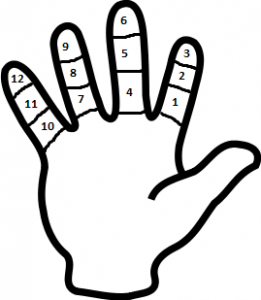Duodecimal system
The duodecimal system (also known as base 12 or dozenal) is a positional notation numeral system using twelve as its base.
 Benefits
Benefits
A base 12 system is better than the decimal system both mathematically and for other practical purposes. Indeed 2,3,4,6 are divisors of 12, which facilitates the fractionalization. Compared to the 2 and 5 divisors of the decimal system, the duodecimal system offers more possibilities.

Counting in tens is a biological accident. There is no doubt that we would have adopted a base 12 system if we had been born with so many fingers, and everything would have been much simpler!
There is nevertheless an effective way to count on one’s fingers in base 12: count the phalanges of the hand by omitting those of the thumb (which is used to count the phalanges of other fingers):
 Kingsland Camp
Kingsland Camp
On base 12, the 10 digits from 0 to 9 are used, followed by the letters A and B, respectively for 10 and 11. (see here), but adding two new digits is a good opportunity to create a new numerical system with much more consistent symbols.
Kingsland Camp described more than one “ideal” set of numerals in his article “Number symbols” (The Duodecimal Bulletin, Vol.2, n°1, page 16).
Here we propose to adopt this system, modifying the symbols’ value so that the 6 is the cipher on the top of a dial:
![]()
The symmetrical geometries of his numerals were intended to more purely convey the digit they represent, by their rotational orientations:
- Halves are represented by {
 ,
,  }, circles with vertical strokes through their centers.
}, circles with vertical strokes through their centers. - Odd quarters by {
 ,
,  }, circles with strokes left or right. {0, 3, 6, 9}
}, circles with strokes left or right. {0, 3, 6, 9}
 The numerals representing the range of quarters { 0, 3, 6, 9 } can be read like clock faces: {
The numerals representing the range of quarters { 0, 3, 6, 9 } can be read like clock faces: { ![]() ,
, ![]() ,
, ![]() ,
, ![]() }.
}.
- Camp’s notation expresses thirds by {
 ,
,  }
}
and the sequence of sixths by { ,
,  ,
,  ,
,  ,
,  ,
,  }.
}.
Thus any numeral representing a sixth of a dozen not already covered by the quarters appears as a “fish” shaped symbol.
- Camp’s notation also treats the other odd numbers { 1, 5, 7, B } in a way that accentuates them, a sharp angular numeral opening up to the numeral’s position on a standard clock face: {
 ,
,  ,
,  ,
,  }
}
 Clock
Clock
Here is an ideal proposal for a duodecimal clock: https://clock.dozenal.ca/clock/diurnal_1
The little needle goes around in one day. It is midnight when it is on 0, and noon when it points to 6 (analogous to the position of the sun at this time of day). Each needle spins 12 times faster than the previous shorter one, so each needle spins 1/12th of a revolution at each complete turn of the next needle.
It is very easy to read the time: just read the number to which the hands point. At noon, it’s 600. This avoids breaking your head if you want to calculate the elapsed time between 11:31:40 and 16:03:20, for example.
16:03:20 – 11:31:40 = 4:31:40 ➜ 804 – 592 = 232
Thank you for referring to my clock labelled Diurnal 1. For the curious, the site you link to offers other versions of the same idea, including a semidiurnal clock and clocks using signed notation. It also has a calendar, a multibase set of clocks, and a set of UTC clocks.
Great site!
Answer this 3d6c+6abf+302 in duodecimal
I don’t even know how to answer it in decimal hahahaha
The idea of using a dozen brand new cyphers is great. It’s a shame there’s that “7” which confuses a bit…
I’m gonna make a 24h clock with your cyphers. Thanks!
Hello Maxime, thank you very much for your feedback. Would you prefer this system?
What about this?
https://drive.google.com/file/d/1mOjZYaCyA0qVoQcs54g1ynEyqZi1Om4V/view?usp=sharing
It made me think of this
It’s interesting, but counting the number of dots to remember the value of the figure seems a bit pointless to me. Normally, if you learn a figure, you learn the figure xD
but on the other hand it’s a good way to rationalise them.
GOOD EXPLANATION
I always preferred the Semi-Diurnal (https://clocks.dozenal.ca/clock/semidiurnal) over Diurnal-1. I don’t really know what sense it would make to reinvent the clock face when we already have a dozenal clock face now.
I like the symbols but would probably swap them around so that ‘0’ is on top instead of on the bottom. People are familiar with the clock, so it would be easier to accept and learn that way. Plus, ‘7’ gets to stay as a ‘seven’, instead of replacing ‘one’.
Thank you for your comment. Well, I proposed this clock as part of the adoption of new numerals. I think that if we can’t get used to a new clock layout, we won’t be able to with new numbers haha! But I think it’s worth confusing one generation to make life easier for the next